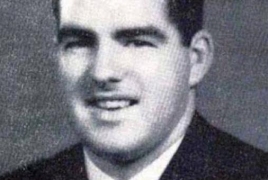 Radiation poisoning victim Harry DaghlianArmenian-born scientist’s fatal experiment 24-year-old Harry Daghlian was irradiated as a result of a criticality accident that occurred when he dropped a tungsten carbide brick onto a 6.2 kg plutonium–gallium alloy bomb core. This core, subsequently nicknamed the "demon core", was also involved in the death of another physicist in an accident the following year. PanARMENIAN.Net - PAN presents the life story of the young scientist and the cause of his death. Haroutune Krikor “Harry” Daghlian Jr. was born in Waterbury, Connecticut, on May 4, 1921. Soon after his birth the family moved across state to the coastal town of New London, Connecticut. He was educated at Harbor Elementary School, where he played violin in the school orchestra, and at Bulkeley High School. Still as a child, Haroutune excelled for his intelligence and interest towards mathematics and natural sciences. His ardor was encouraged by his father, X-ray specialist Krikor Daghlian, and uncle, a teacher of physics and astrology, Dr. Karapet Daghlian. In 1938, at the age of 17, he entered the Massachusetts Institute of Technology, intending to study mathematics, but became interested in physics, particularly particle physics, then emerging as an exciting new field. This led him to transfer to the West Lafayette, Indiana, campus of Purdue University, which graduated him in 1942 with a Bachelor of Science degree. He then commenced work on his doctorate, assisting Marshall Holloway with the cyclotrons. In 1944, while still a graduate student, he joined Otto Frisch's Critical Assembly Group at the Los Alamos Laboratory of the Manhattan Project, which was a research and development project that produced the first nuclear weapons during World War II. It was led by the United States with the support of the United Kingdom and Canada. On August 21, 1945, Daghlian was conducting several criticality experiments with a plutonium core that turned out fatal for him. Daghlian was placing brick-shaped pieces of metal around a chunk of plutonium, the highly unstable fuel used in most nuclear bombs. And he was making it more unstable with every brick he placed around it. He was moving the final brick over the assembly, but neutron counters alerted Daghlian to the fact that the addition of that brick would render the system supercritical. As he withdrew his hand, he inadvertently dropped the brick onto the center of the assembly. Since the assembly was nearly in the critical state, the accidental addition of that brick caused the reaction to go immediately into the prompt supercritical region of neutronic behavior. It’s not yet known why there was no one in the laboratory except Daghlian at that fatal hour. Although he knew that being the room alone was a violation of rules, he did not obey. The guard sitting near the laboratory, whose responsibility was securing fire safety only, did not prevent the young scientist from entering. Daghlian was estimated to have received a dose of 510 rem (5.1 Sv) of neutron radiation, from a yield of 1016 fissions. Despite intensive medical care, he developed symptoms of severe radiation poisoning and fell into a coma. He died after a painful battle 25 days after the accident. He was the first known fatality caused by a criticality accident. His body was returned to New London, where he was buried in Cedar Grove Cemetery. Daghlian’s family members learned about the real cause of his death years later. They did not even know that he participated in Manhattan Project. The U.S. army said Daghlian died in an accident in the chemical laboratory. Just a few weeks before Daghlian's experiment, two atomic bombs were dropped on the Japanese cities of Hiroshima and Nagasaki. The bombs killed at least 100,000 people immediately, and many tens of thousands more in the days that followed. American author Joe McGinniss, who investigated the death circumstances of the victims of nuclear experiments, said that the authorities deliberately concealed the truth to avoid public questions. Nine months after Daghlian's death, in May 1946, the core that he had been experimenting on was designated for use in an actual bomb, to be exploded in a test over the Pacific Ocean. On May 21, Louis Slotin, Daghlian's friend and colleague (he had been on vacation during the accident) decided to perform one last experiment on it. Slotin's experiment was similar to Daghlian's, but instead of using bricks of tungsten carbide, he had two bowl-like hemispheres made of beryllium -another metal that acts as a neutron reflector. (The two hemispheres could be put together to form a hollow ball; the hollow was just the right size to hold the plutonium core.) One of the hemispheres sat in a frame on a table. Slotin placed the plutonium core in it, then placed the other hemisphere over the top of the core but not all the way. He could not cover the core and allow it to be completely surrounded by the neutron-reflecting beryllium or, as happened to Daghlian, an uncontrolled chain reaction would occur. Daghlian’s work was not forgotten. He was memorialized on May 20, 2000, by the city of New London, with the erection of a memorial stone and flagpole in Calkins Park, which was unveiled by his brother and sister. It read: "though not in uniform, he died in service to his country." Samson Hovhannisyan / PanARMENIAN.Net A non-exhaustive summary of war crimes Months-long project in Italy highlights culture and nation From an American Colonel's report A timeline of how the war machine was set in motion The situation is scarier than one can imagine And the Pulitzer Prize went to… a lot of Armenians Azerbaijan’s violence in April War |